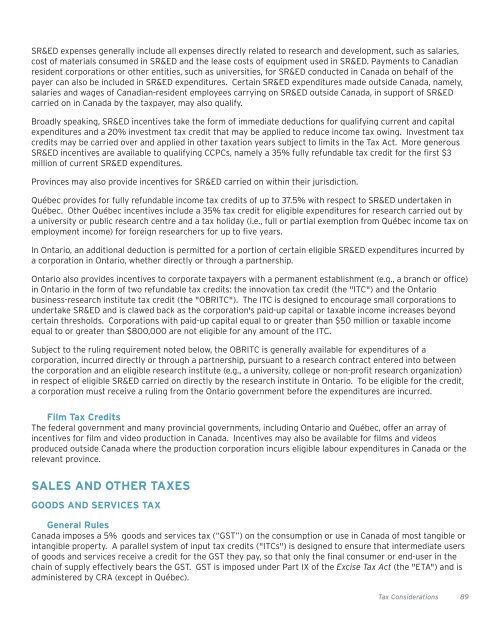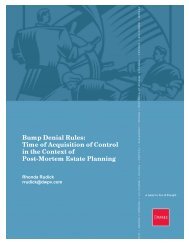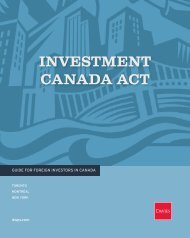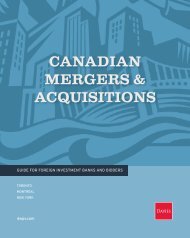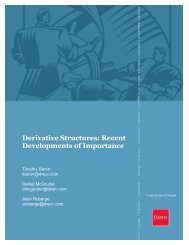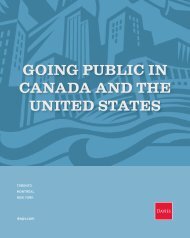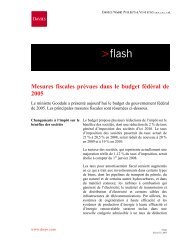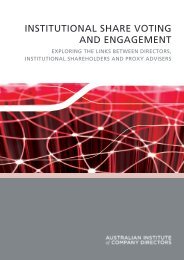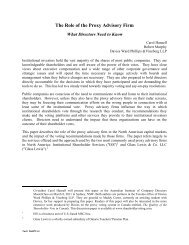SR&ED expenses generally <strong>in</strong>clude all expenses directly related to research and development, such as salaries,cost of materials consumed <strong>in</strong> SR&ED and the lease costs of equipment used <strong>in</strong> SR&ED. Payments to Canadianresident corporations or other entities, such as universities, for SR&ED conducted <strong>in</strong> Canada on behalf of thepayer can also be <strong>in</strong>cluded <strong>in</strong> SR&ED expenditures. Certa<strong>in</strong> SR&ED expenditures made outside Canada, namely,salaries and wages of Canadian-resident employees carry<strong>in</strong>g on SR&ED outside Canada, <strong>in</strong> support of SR&EDcarried on <strong>in</strong> Canada by the taxpayer, may also qualify.Broadly speak<strong>in</strong>g, SR&ED <strong>in</strong>centives take the form of immediate deductions for qualify<strong>in</strong>g current and capitalexpenditures and a 20% <strong>in</strong>vestment tax credit that may be applied to reduce <strong>in</strong>come tax ow<strong>in</strong>g. Investment taxcredits may be carried over and applied <strong>in</strong> other taxation years subject to limits <strong>in</strong> the Tax Act. More generousSR&ED <strong>in</strong>centives are available to qualify<strong>in</strong>g CCPCs, namely a 35% fully refundable tax credit for the first $3million of current SR&ED expenditures.Prov<strong>in</strong>ces may also provide <strong>in</strong>centives for SR&ED carried on with<strong>in</strong> their jurisdiction.Québec provides for fully refundable <strong>in</strong>come tax credits of up to 37.5% with respect to SR&ED undertaken <strong>in</strong>Québec. Other Québec <strong>in</strong>centives <strong>in</strong>clude a 35% tax credit for eligible expenditures for research carried out bya university or public research centre and a tax holiday (i.e., full or partial exemption from Québec <strong>in</strong>come tax onemployment <strong>in</strong>come) for foreign researchers for up to five years.In Ontario, an additional deduction is permitted for a portion of certa<strong>in</strong> eligible SR&ED expenditures <strong>in</strong>curred bya corporation <strong>in</strong> Ontario, whether directly or through a partnership.Ontario also provides <strong>in</strong>centives to corporate taxpayers with a permanent establishment (e.g., a branch or office)<strong>in</strong> Ontario <strong>in</strong> the form of two refundable tax credits: the <strong>in</strong>novation tax credit (the "ITC") and the Ontario<strong>bus<strong>in</strong>ess</strong>-research <strong>in</strong>stitute tax credit (the "OBRITC"). The ITC is designed to encourage small corporations toundertake SR&ED and is clawed back as the corporation's paid-up capital or taxable <strong>in</strong>come <strong>in</strong>creases beyondcerta<strong>in</strong> thresholds. Corporations with paid-up capital equal to or greater than $50 million or taxable <strong>in</strong>comeequal to or greater than $800,000 are not eligible for any amount of the ITC.Subject to the rul<strong>in</strong>g requirement noted below, the OBRITC is generally available for expenditures of acorporation, <strong>in</strong>curred directly or through a partnership, pursuant to a research contract entered <strong>in</strong>to betweenthe corporation and an eligible research <strong>in</strong>stitute (e.g., a university, college or non-profit research organization)<strong>in</strong> respect of eligible SR&ED carried on directly by the research <strong>in</strong>stitute <strong>in</strong> Ontario. To be eligible for the credit,a corporation must receive a rul<strong>in</strong>g from the Ontario government before the expenditures are <strong>in</strong>curred.Film Tax CreditsThe federal government and many prov<strong>in</strong>cial governments, <strong>in</strong>clud<strong>in</strong>g Ontario and Québec, offer an array of<strong>in</strong>centives for film and video production <strong>in</strong> Canada. Incentives may also be available for films and videosproduced outside Canada where the production corporation <strong>in</strong>curs eligible labour expenditures <strong>in</strong> Canada or therelevant prov<strong>in</strong>ce.SALES AND OTHER TAXESGOODS AND SERVICES TAXGeneral RulesCanada imposes a 5% goods and services tax (“GST”) on the consumption or use <strong>in</strong> Canada of most tangible or<strong>in</strong>tangible property. A parallel system of <strong>in</strong>put tax credits ("ITCs") is designed to ensure that <strong>in</strong>termediate usersof goods and services receive a credit for the GST they pay, so that only the f<strong>in</strong>al consumer or end-user <strong>in</strong> thecha<strong>in</strong> of supply effectively bears the GST. GST is imposed under Part IX of the Excise Tax Act (the "ETA") and isadm<strong>in</strong>istered by CRA (except <strong>in</strong> Québec).Tax Considerations 89
A person, whether resident <strong>in</strong> Canada or non-resident, who <strong>in</strong> the course of commercial activities makes asupply (def<strong>in</strong>ed <strong>in</strong> the ETA as a "taxable supply") of property or a service <strong>in</strong> Canada is generally required toregister for the GST unless the person's aggregate annual world-wide taxable supplies do not exceed $30,000.Therefore, any non-resident that makes a taxable supply <strong>in</strong> Canada and has worldwide non-exempt sales of$30,000 or more (<strong>in</strong>clud<strong>in</strong>g non-Canadian sales) will generally be required to register for the GST. For thepurposes of the ETA, "person" is def<strong>in</strong>ed broadly to <strong>in</strong>clude, among other th<strong>in</strong>gs, an <strong>in</strong>dividual, a corporation, atrust, and a partnership.Exempt SuppliesThe supply of certa<strong>in</strong> types of property and services, def<strong>in</strong>ed <strong>in</strong> the ETA as an "exempt supply", is expresslyexempted from the GST. The most common types of exempt supplies are:• supplies of f<strong>in</strong>ancial services (such as loans or securities transactions, <strong>in</strong>clud<strong>in</strong>g the sale or issuance ofshares, and some related services);• supplies (<strong>in</strong>clud<strong>in</strong>g sales and leases) of used residential real estate;• certa<strong>in</strong> supplies made by Canadian charities or other non-profit entities; and• supplies of most medical and dental services.Zero-Rated SuppliesThe supply of certa<strong>in</strong> types of property or services, def<strong>in</strong>ed <strong>in</strong> the ETA as a "zero-rated supply", is treated as a"taxable supply", but with the rate of tax be<strong>in</strong>g 0%, i.e., no GST is charged.The pr<strong>in</strong>cipal categories of zero-rated supplies are:• supplies of most forms of property or services for export;• supplies of prescription drugs and basic groceries;• supplies of certa<strong>in</strong> agricultural products; and• supplies of most forms of f<strong>in</strong>ancial services to a non-resident.Input Tax CreditsIn general terms, a registrant engaged exclusively <strong>in</strong> mak<strong>in</strong>g taxable supplies (<strong>in</strong>clud<strong>in</strong>g zero-rated supplies) isentitled to claim ITCs equal to all GST that the registrant has paid <strong>in</strong> connection with property or servicesacquired for consumption, use or supply <strong>in</strong> its commercial activities. Conversely, a supplier who is engagedexclusively <strong>in</strong> mak<strong>in</strong>g exempt supplies is not entitled to claim ITCs. A registrant who makes both exempt andtaxable supplies must allocate its GST expense reasonably between the two activities, and is generally permittedto claim ITCs only for the GST expense allocated to the mak<strong>in</strong>g of taxable supplies.Collection and Report<strong>in</strong>gAlthough the GST is payable by the recipient, a supplier which is (or is required to be) a registrant for GSTpurposes is liable, <strong>in</strong> most cases, to collect and remit the GST payable by the recipient to the federal governmenton a periodic basis. The supplier may net its ITCs aga<strong>in</strong>st the GST collected and thus remit only the balance (ifany) to the federal government. If the supplier's ITCs exceed the GST collected <strong>in</strong> any report<strong>in</strong>g period, thefederal government will refund the excess to the supplier.90 Tax Considerations
- Page 1 and 2:
DOING BUSINESSIN CANADAYOUR COMPLET
- Page 3 and 4:
ONTENTSTABLE OF CONTENTSINTRODUCTIO
- Page 5 and 6:
IntroductionPOLITICAL AND CONSTITUT
- Page 7 and 8:
5RealEstateIndustrial and Intellect
- Page 9 and 10:
accordance with directions from the
- Page 11 and 12:
TITLE INSURANCE, TITLE OPINIONS AND
- Page 13 and 14:
11EnvironmentalLawIndustrial and In
- Page 15 and 16:
commercial activities, or carrying
- Page 17 and 18:
The federal government currently re
- Page 19 and 20:
17Types ofBusiness OrganizationIndu
- Page 21 and 22:
provincial law cannot do so as of r
- Page 23 and 24:
partnership, limited partners’ li
- Page 25 and 26:
parties. In Québec, joint venturer
- Page 27 and 28:
25Financing aBusiness OperationIndu
- Page 29 and 30:
The Civil Code of Québec provides
- Page 31 and 32:
29CorporateGovernanceIndustrial and
- Page 33 and 34:
Instrument 58-101. The practices re
- Page 35 and 36:
33CompetitionLawIndustrial and Inte
- Page 37 and 38: BID-RIGGINGBid rigging is any agree
- Page 39 and 40: anticompetitive agreements among co
- Page 41 and 42: 39ForeignInvestmentIndustrial and I
- Page 43 and 44: apply for Canadian citizenship. (Pe
- Page 45 and 46: (D)GENERAL REVIEW THRESHOLDSThe fol
- Page 47 and 48: there be an "acquisition of control
- Page 49 and 50: Industrial and Intellectual Propert
- Page 51 and 52: to perform or cause them to be perf
- Page 53 and 54: Registration grants an exclusive ri
- Page 55 and 56: PIPEDA applies in all provinces of
- Page 57 and 58: Employment LawCanadian employment l
- Page 59 and 60: displacement, laying-off, suspensio
- Page 61 and 62: easonable cause to believe that the
- Page 63 and 64: 63Retirement Plans, EmployeeBenefit
- Page 65 and 66: • funding;• eligibility;• pen
- Page 67 and 68: 67Temporary Entry andPermanent Resi
- Page 69 and 70: INTERNATIONAL AGREEMENTSIn recent y
- Page 71 and 72: immigrant in another class, he or s
- Page 73 and 74: 73Bankruptcy andInsolvency Proceedi
- Page 75 and 76: BANKRUPTCYBankruptcy results in the
- Page 77 and 78: INTERNATIONAL BANKRUPTCYASSETS LOCA
- Page 79 and 80: Tax ConsiderationsThis chapter prov
- Page 81 and 82: TAX REPORTINGAnnual Tax ReturnsCana
- Page 83 and 84: Québec has legislation that limits
- Page 85 and 86: Amendments, SIFTs and their unithol
- Page 87: Conversely, where a Canadian reside
- Page 91 and 92: APPENDIX I: CANADA’S IN FORCE TAX
- Page 93: TORONTODAVIES WARD PHILLIPS & VINEB


